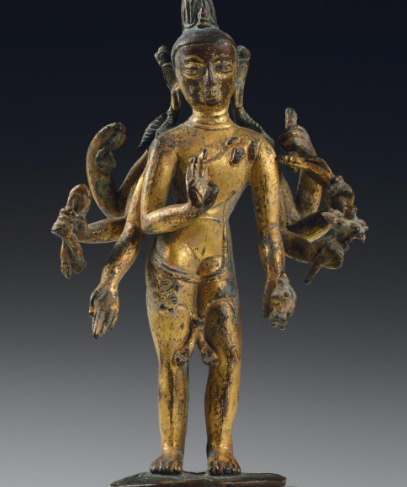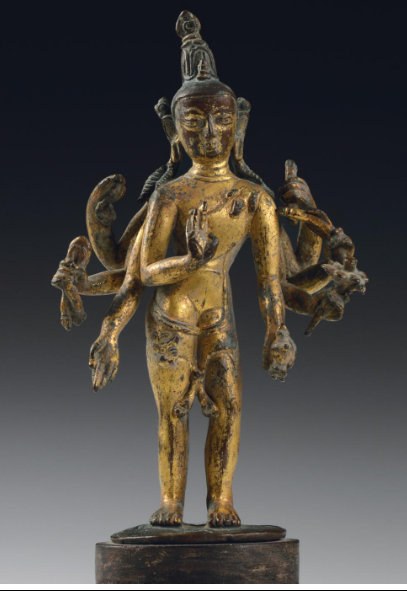Details
- Title : AMOGHAPASHA LOKESHVARA
- Year : 15th Century
- Classification : Sculpture
- Medium : Gilt-bronze
- Dimension : Height 5 1/4 in. (13.3 cm.)
- Accession No : GNM_LOT 99_PUN_10
- Country/ Geo-location : Nepal
- Collection : PUNDOLE’S
- Status : LIVE AUCTION The Art of the Himalayas from the Collection of Roshan Sabavala (M0009) (As per NOV 2021)
- ESTIMATED : ₹300,000 - ₹500,000
- SOLD : ₹600,000
- NOTE : This charming gilt-bronze depicts the bodhisattva Amoghapasha Avalokiteshvara in a similar iconographical form to another in the Sabavala Collection, lot 96, with eight arms and all his hand-held attributes, the rosary and vajra noose in the right hands, and the manuscript, trident, lotus flower and water pot in the left, and standing in an elegant tribangha posture. This example is distinguished, however, by the lack of bodhisattva ornaments. There is no jewelled crown, nor bracelets and necklaces that traditionally adorn a bodhisattva, as seen in the other Amoghapasha in the collection. Instead he is portrayed as an ascetic wearing a flayed antelope skin over his left shoulder and a tiger skin loincloth, with the legs of the tiger tied as a falling sash at the knee and the tiger's head resting on the deity's right thigh. A diminutive figure of Amitabha Buddha, the bodhisattva's spiritual progenitor, is seated in the matted hair that is drawn up in long plaits with a jewel surmounting the tall jatamakuta. He wears flowers above the ears. This unusual iconography, reminiscent of the ascetic forms of Shiva, has an antecedent however in the 8th or 9th century Nepalese Nyingjei Lam Amoghapasha, who also wears an antelope skin over the shoulder and with no jewellery whatsoever, see David Weldon and Jane Casey Singer, The Sculptural Heritage of Tibet: Buddhist Art in the Nyingjei Lam Collection, London, 1999, p. 51, pl. 9.

